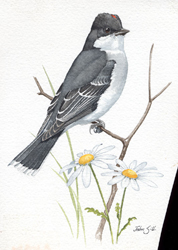Breeding Bird Atlases (BBA)
Find a Bird - BBA1
Breeding Bird Atlas 1 Species Accounts
Eastern Kingbird
Tyrannus tyrannus
Egg Dates
May 30 to July 17
Number of Broods
one; may re-lay if first attempt fails.

The Eastern Kingbird is a common breeding bird throughout the state, and during the Atlas period it was confirmed in all regions, including Cape Cod and the Islands. Perched conspicuously in the open on an exposed branch, fence, or telephone wire or darting out in flight with rapid, fluttering wing beats, the Eastern Kingbird is a familiar sight in all types of open country. Its intolerance of large birds, and sometimes of smaller species as well, along with its aerial attacks on crows, hawks, and vultures, has rightfully earned it its present common name, as well as its former appellation—Tyrant Flycatcher.
Kingbirds may begin to arrive in Massachusetts in late April, but there are no appreciable numbers until early May, with migration continuing through the middle of the month. Fairly large nesting territories are established in orchards, farmlands, old overgrown pastures, wood borders, and suburbs, and any such area with a stream or pond included is especially favored. While the birds may occasionally be found in open woods, especially those that have been partially logged, they do not occur in dense forest.
Courting males perform twisting, tumbling flights with their characteristic short, quick wing beats and vocalize steadily. At times, particularly dawn and dusk, the birds may ascend to considerable heights. The common calls are various shrill tzi and tzee notes, which may be given singly or in a series. The male’s song is actually a series of such calls uttered in an alternating pattern: tzi-tzee-tzi-tzee-tzi-tzee. In addition, there are also several kip and kipper notes, again given in the same varying sequences.
Nests are generally placed from 2 to 60 feet high in a shrub or tree, often near or over water. Massachusetts nests have been recorded in elm, Norway Spruce, honeysuckle, Beach Plum, crabapple, apple, pear, alder, Buttonbush, Red Maple, and White Ash (CNR, Petersen). Heights ranged from 4 to 40 feet. Both sexes gather straw, twigs, grass, and even string and strips of cloth for the construction of a bulky cup nest, which appears somewhat rough and ragged on the outside but has a neat interior lined with fine grasses, rootlets, hair, and plant down. The earliest date for nest building in the state was May 10 (CNR).
Typical clutches consist of three or four (rarely five) eggs, which are white with irregular brownish blotches. The clutch sizes for 6 Massachusetts nests were three eggs (3 nests) and four eggs (3 nests) (DKW, CNR). The female does most of the incubating for 12 to 14 days, while the ever-watchful male remains perched nearby. Young remain in the nest for about two weeks and have been reported in Massachusetts from June 24 to July 24. Brood size in 4 state nests was two young (1 nest), three young (2 nests), and four young (1 nest) (CNR). Fledglings being fed by their parents have been observed in the Commonwealth from June 26 to August 4 (CNR, Meservey). Although some sources state that kingbirds raise two broods in a season, this has not been documented in Massachusetts. However, it is a well-known fact that if the first attempt fails, the birds will readily renest.
Both parents continue to feed the fledglings for at least one week after the latter leave the nest. The young perch on a wire or branch and beg with a rough tzee note. Much of this kingbird’s diet consists of insects caught on the wing or picked from the ground or water’s edge in hovering flight. Formerly labeled the Bee Martin and persecuted by humans, the Eastern Kingbird in fact does not eat a significant number of honeybees. Small wild fruits are also taken. At times, the birds bathe in flight, swooping low over the water and repeatedly dropping onto the surface.
The families remain together as a unit well into August. Old and young alike depart before completing their molts. By the end of the month, migration is in full swing, and small loose flocks sometimes form. Most have departed by early September, although transients continue to pass throughout the month. After this, only stragglers are recorded. The Eastern Kingbird winters from southern Central America to northern South America.
Map Legend and Data Summary
Atlas 1 data collected from 1975-1979


Note: common throughout the state in open areas, especially near water
W. Roger Meservey



